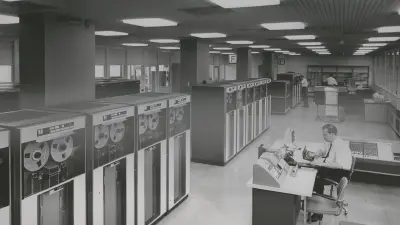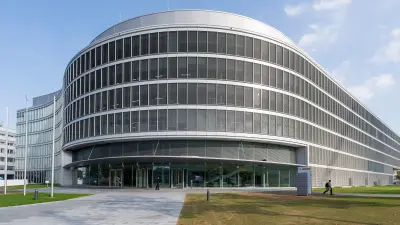Information Systems and Services @Bosch

In 1958, the author of the in-house newspaper “Bosch-Zünder” was awestruck by the capabilities of a new technical all-rounder – Bosch had seen the arrival of its first computer.
“It can sense punch cards, that is, it reads the data and saves it on a magnetic drum, just as someone with a head for figures can retain numbers — only it retains far more, numbers, in inconceivably vast quantities, and it does so without forgetting anything. It can count, store the results onto punch cards, and write the data in words and numbers on paper”. What had until now been regarded as a uniquely human skill — i.e. registering, processing, and storing information — could now be performed to a certain degree by a machine. Not only that, the computer actually worked much faster and much more accurately.
The magnetic drum computer was initially intended to rationalize office work. The system evaluated the performance of the individual piecework groups at the pump plant in Stuttgart-Feuerbach each day and calculated the weekly wages. It could print 30 completed net wage sheets a minute — the same time it took an office worker to perform three simple multiplications.
He was sufficiently encouraged by the positive results of this experiment to move toward a permanent eight-hour day. Contrary to general expectation, there was no reduction in the quantity of goods produced per shift, even though working time had been cut by one hour. Indeed, productivity actually increased slightly.
The eight-hour working day wasn’t the only special feature Robert Bosch had to offer as an employer.

New tasks for man and machine

The second mainframe computer of the IBM 700/7000 series, which was commissioned in 1961, was assigned initial control tasks and administered large parts of the central Feuerbach warehouse independently. (For comparison, around the same time, a similar model in the IBM 700/7000 series helped NASA compute its first manned spaceflight program — Project Mercury.) Following the launch of a new and extended generation of mainframe computers in 1971, Bosch took an important step as the first company in Europe to start using the IBM Series 370 / Model 165. Although a great deal of money was needed to operate the system, it was “fully justified due to the sheer unending “hard work” the machine was capable of and the unbelievable speed” with which it could run 15 programs at the same time. It took some 120 associates to operate the machine. They performed a diverse range of tasks, including technical configuration, programming, data entry, cutting the printed lists, and storing the magnetic tapes.
Digital World
The new technology quickly spread into new areas. Computers became an everyday sight at Bosch in 1998, when the PC was introduced as standard equipment for every workstation – some 40 years after the company had first started using computers.
What about today? Efficient, future-focused work processes are digital and networked. To keep them running smoothly on a daily basis, some 7,500 IT experts are responsible for maintaining digital workstations and applications at over 390 Bosch locations in 60 countries. Over 2,000 of them are now based at the new IT Campus in Stuttgart-Feuerbach.

Author: Bettina Simon
